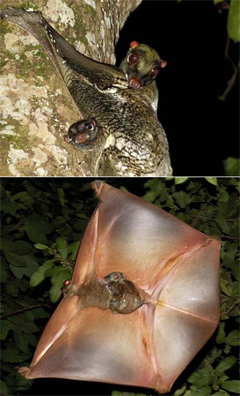New species of flying lemurs discovered
mongabay.com
November 10, 2008
|
|
A new study has found that colugos or flying lemurs are twice as diverse as previously believed.
Comparing the DNA of colugos across southeast Asia, an international team of researchers has found that Sunda colugo — one of two known species of colugo (the other is the Philippine colugo) — is actually made up of at least three species, which date back millions of years.
“We were guessing that we might find that there were different species of Sunda colugo—although we were not sure,” said Jan Janecka of Texas A&M University. “But what really surprised us was how old the speciation events were. Some went back four to five million years.”
 Colugo female with offspring on tree and gliding. Image courtesy of Norman Lim, National University of Singapore. “Flying lemur” is a misnomer &8212; colugos are not lemurs (but they are primates) and they do not fly (they glide). |
The researchers speculate that the species tally is likely to rise as more research is done. Janecka says that that colugos’ high degree of speciation may be explained by their mode of locomotion — gliding between tall rainforest trees. Colugos are virtually incapable of crossing large open ground and populations would be been isolated and fragmented by the changes in sea levels and forest communities across their range over the past 10 million years.
The findings are likely to have conservation implications in a landscape that is rapidly being destroyed by loggers and industrial agriculture developers.
“Until now, reductions in colugo numbers was considered just a range contraction, and so there were no conservation plans for restoring them or mitigating their loss,” Janecka said. “However, this is no longer the case; we now need to re-assess the status of each of these species to determine which of them are under threat of extinction, and develop conservation plans that ensure their persistence. In addition, some of the small isolated populations that were previously described as subspecies may also represent new species, which could disappear before we even realize they exist.”
The research is published in the November 11th issue of Current Biology.